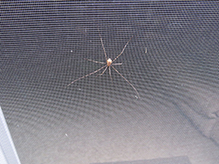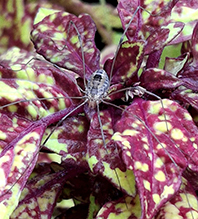Common harvestman
(Phalangium opilio)
Conservation • Description • Habitat • Ecology • Distribution • Taxonomy
Conservation Status |
|||
| IUCN Red List | not listed |
||
| NatureServe | N5 - Secure |
||
| Minnesota | not listed |
||
Description |
Common harvestman is the most widespread species of harvestman in the world. It is the most often encountered harvestman in anthropic areas. It is native to Europe. It was introduced into North America, and it is now widespread throughout the United States and Canada. The body is relatively “chunky” or oval, with the carapace and abdomen smoothly fused. There is almost always has a dark, saddle-shaped marking on the back, often with a lighter border. Males often have darker, more mottled bodies, so the saddle can be less sharply outlined but is still there if you look closely. The legs can have faint or broken bands, even quite subtle bands. |
Size |
Body Length: ⅛″ to ¼″ |
Similar Species |
Leiobunum bodies tend to be rounder and more compact. The legs are very long, even for a harvestman, and they tend to be strongly banded. |
Habitat |
Disturbed areas; open areas on foliage and tree trunks. |
Ecology |
Season |
|
Behavior |
|
Life Cycle |
|
Food |
|
Distribution |
||
|
Sources |
|
| 9/17/2025 | ||
Occurrence |
||
Extremely common and very widespread |
||
Taxonomy |
|
Class |
|
Order |
Opiliones (harvestmen) |
Suborder |
Eupnoi |
Superfamily |
Phalangioidea |
Family |
Phalangiidae |
Subfamily |
Phalangiinae |
Genus |
Phalangium |
Subordinate Taxa |
|
|
|
Synonyms |
|
Cerastoma aduncum Cerastoma brevicornis Cerastoma capricorne Cerastoma cornutum Cerastoma curvicornis Cerastoma dentatum Cerastoma tirolense Opilio angulatichelis Opilio molluscus Opilio praefectus Phalangium brevicorne Phalangium cornutum Phalangium longicorne Phalangium longipalpis Platybunus nigrovittatus ssp. hungaricus |
|
Common Names |
|
brown daddy long legs common harvestman daddy long legs daddy-long-legs eastern daddy long legs European harvestman harvestman |
|
Visitor Photos
Share your photo of this arachnid.
This button not working for you?
Simply email us at info@MinnesotaSeasons.com.
Attach one or more photos and, if you like, a caption.
Nancy Lundquist |
 |
What is this? I thought it was easy...a daddy long legs. It doesn't match any of the spiders when I put it in Google search. |
Luciearl |
||
 |
 |
|
Found on Coneflower |
||
|
||
harvestman |
|
|
 |
|
|
Alfredo Colon |
||
 |
||
MinnesotaSeasons.com Photos
 |

Slideshows

Visitor Videos
Share your video of this arachnid.
This button not working for you?
Simply email us at info@MinnesotaSeasons.com.
Attach a video, a YouTube link, or a cloud storage link.
Other Videos
Weberknecht Phalangium opilio Macro Video
Chrigu wälti

Visitor Sightings
Report a sighting of this arachnid.
This button not working for you?
Simply email us at info@MinnesotaSeasons.com.
Be sure to include a location.
Nancy Lundquist
9/16/2025
Location: West St. Paul
What is this?
I thought it was easy...a daddy long legs. It doesn't match any of the spiders when I put it in Google search.
John Valo
9/17/2025
The common harvestman (Phalangium opilio) is not native, but it is very common and widespread in North America. It is the most commonly encountered harvestman in many parts of the United States and Canada, especially in disturbed or urban areas. It is particularly well-adapted to live in human-modified habitats like gardens, yards, and even on the exterior of houses. It is known for its preference for vertical surfaces like walls and tree trunks, which makes it a frequent visitor to windows and siding. Therefore, if you find a harvestman on a window screen or the side of your house, it's very likely to be Phalangium opilio.
Phalangium opilio often has a distinct dark, saddle-shaped marking on its back, and the legs can have faint bands. Coloration on females is highly variable. Some Leiobunum species are also quite common in human environments. Their legs are often exceptionally long and tend to be more strongly banded than P. opilio.
The harvestman in your photo doesn't appear to be a Leiobunum species, primarily due to the proportionally shorter leg length. While a definitive identification isn't possible from this photo alone, the combination of its appearance and location makes it highly probable that this is a female Phalangium opilio.








